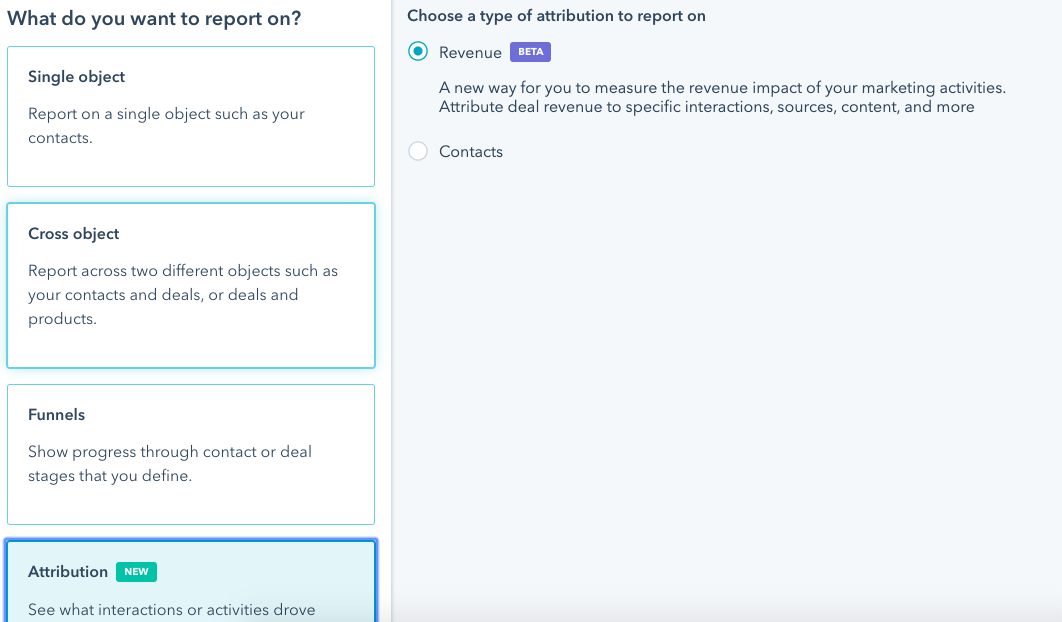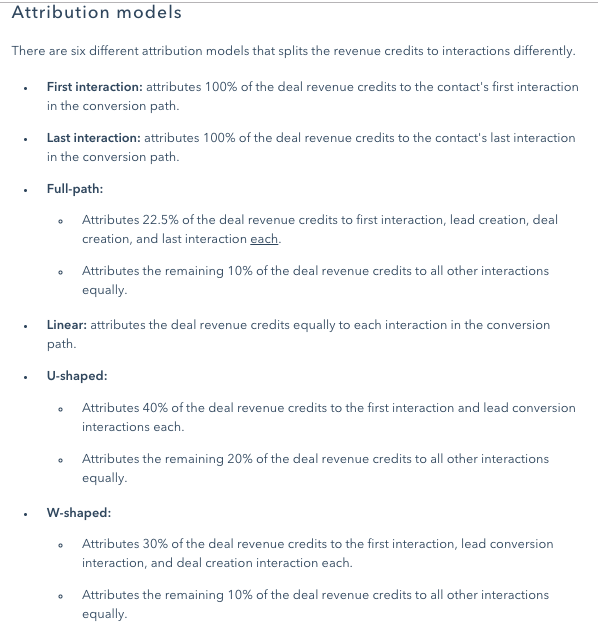As someone who has consulted with HubSpot customers for a couple of years, I always hear similar feedback about our reporting functionality.

“We need to show ALL the interactions a customer took in their journey to provide credit back to marketing in one report!”
I understand what they are asking for. They're talking about the dreaded A-word: Attribution. It produces feelings of anxiety and confusion whenever my customers — particularly marketers — mention it. Marketing teams are fearful that they will not find anything, or enough evidence of their role in lead acquisition and closed won deals, to be allocated for next year’s budget.
Businesses are increasingly pressured to provide evidence of the value of their work. At HubSpot's 2019 INBOUND conference, HubSpot announced that we would be releasing multi-touch attribution reporting. As of October 1, you have this brand new tool in your reporting. Multi-touch attribution provides marketing teams the data needed to showcase the fruits of their labor.
Multi-touch attribution reporting is different from the prior functionality HubSpot possessed. Jorie Munroe wrote a blog post detailing that functionality, which showed contacts who converted and/or influenced through particular conversion paths. Multi-touch attribution reporting allows teams to set up parameters and assign credit to various teams for a customer who is going through the buyer's journey.
Requirements
HubSpot empowers you with our multi-touch attribution reporting functionality to measure the effectiveness of your marketing initiatives. But there are a few requirements to be mindful of:
- You need access to HubSpot's Marketing Enterprise product. This will help you construct the touchpoints or sources that assisted in the conversion of a contact on any of your website’s forms, all the way to when a deal is closed with your sales team.
- You need access to HubSpot's custom reporting functionality. This is a form of custom reporting under attribution, much like the other categories: Single-object, Cross-object, and Funnels/Pipelines.
- You need to use HubSpot Sales—particularly our deals. Our multi-touch attribution reporting tracks revenue based on how many deals are Closed-Won within your HubSpot instance. This is required so that you can measure all parts of someone’s interactions with your business: First Interaction, Lead Creation, Deal Creation, and Closed-Won. An integration — native or more customized — that syncs your deals into HubSpot should suffice.
Provided that you meet these requirements, you can take full advantage of the multi-touch attribution reporting HubSpot has to offer.
Functionality Walk-through
You can find the multi-touch attribution reporting under the custom reporting menu within Attribution Reports, located either through your dashboard or under Reports Home.

When clicking this, you will notice that the User Interface (UI) is a little different than what you are used to when building a custom report in HubSpot. There are no data or visualization tabs, nor are there options to include filters. Instead, you will see two tabs named explore and configure.
The explore tab has a link to an introductory video on the functionality. Below the video, you can see select questions. Depending on what you click on, our UI will show the particular report that matches the problem or link between marketing activities and revenue generation. This will give those who are not used to multi-touch attribution reporting models a way to start thinking about how they want to best structure their reporting for better decision making.
Click the configure tab to open up a list of options from where you can put together the attribution report that makes the most sense to you and your team.
- Chart type allows you to change the visualization, depending on how you are planning to review the model that you pick.
- Deal close date allows you to choose the timeline based on when a deal was closed.
- Deal pipelines allows you to segment a particular report into a specific pipeline instead of all deals closed. Realistically, this option is only possible for HubSpot customers that have a paid Sales hub subscription where multiple deal pipelines are available.
- Interactions will provide you the chance to distinguish efforts to revenue generation between marketing qualified efforts as opposed to more sales-oriented prospecting and engagement to generating revenue.
- Dimensions will give you the ability to add 2 types of characteristics, best defined by the text below, as drawn from the Knowledge Base article on the subject.
- Campaign: Select to assign deal revenue credits by a specific campaign name. Non-campaign data will be included in this as well.
- Content type: select to assign deal revenue credits by content type. Content types include content on your site like website pages, landing pages, blog posts, and knowledge articles. It also encompasses other types of content such as logged calls and meetings and social posts
- Content title: select to assign deal revenue credits by the titles of your content. Where the content does not have a title, the URL of the content will be displayed.
- Deal: select to assign deal revenue credits by deal.
- Deal pipeline: select to assign deal revenue credits by deal pipeline.
- Deal type: select to assign deal revenue credits by deal type.
- Interaction source: select to assign deal revenue credits by interaction source.
- Interaction type: select to assign deal revenue credits by interaction type.
- Attribution Models are the rule or set of rules available for you to change or add (for comparison purposes) in order to accurately measure credit in favor of various touchpoints, which influenced the closing of business.

Benefits of Multi-touch Attribution Reporting
HubSpot's existing version of attribution reporting only shows the number of contacts generated from a conversion path — focusing on a single interaction to convert the visitor into a lead. Our multi-touch attribution reports can be added as a report on one's dashboards or Reports Home. Once added on to dashboards, these reports can be emailed to others on a one-off or recurring basis to help spur conversations about the return on investment in your marketing activities — content creation, lead generation, and operations.
Beyond the ability to advocate for an increase in future team budgets, your organization can gauge which sources and assets aided in the interaction, conversion, deal creation, and attribution of closed-won revenue. In particular, this will provide marketing teams the hard evidence to convince their organization the need to invest in and amplify similar resources in the future.
Importantly, this allows non-Marketing teams within an organization to start conversations about aligning around common business goals and team or individual metrics working toward those business goals. Moreover, the interactions option will give sales teams a chance to showcase outreach that originated with sales as well as a distinguishing factor to compare against marketing’s contribution.
Attribution will become increasingly important as your business scales. Therefore, it is imperative to have the resources and tools available to visualize your data that increases alignment and help your business grow better.
Want to connect with others on HubSpot tips, tricks, and updates? Head over to the HubSpot Community to join a conversation or start one of your own.
